 As experienced restorers will tell you, the last thing that should deter anyone when deciding on a particular vehicle to restore is the state of its paintwork.
As experienced restorers will tell you, the last thing that should deter anyone when deciding on a particular vehicle to restore is the state of its paintwork.
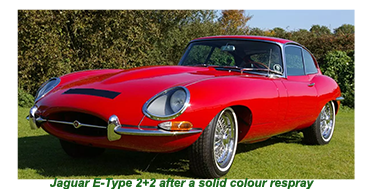 The best scenario they can hope to find is that the car still has its original paintwork, although probably well faded with spots of rust here and there- an ideal basis on which to build for any classic car restoration project- although they rarely get that lucky and will need to apply some paintwork.
The best scenario they can hope to find is that the car still has its original paintwork, although probably well faded with spots of rust here and there- an ideal basis on which to build for any classic car restoration project- although they rarely get that lucky and will need to apply some paintwork.
Once the preparations are well underway, the time is rapidly approaching for the restorer to decide how they want their classic car to look as it makes its debut into the world as a finished item.
It is not just a question of choosing the right colour; issues such as car paint and finish have to be addressed.
If the necessary research is put in and a firm decision is made before the car hits the paint shop, it will play an essential part in deciding which steps to be taken during the final preparation.
The first stage is to decide which paints will be used, with the most common car paints as follows:
Urethane: Urethane car paint is the most durable and long-lasting paint available, guaranteed not to fade for at least a decade.
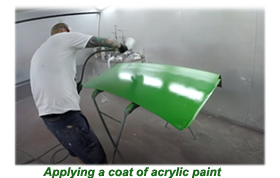
 Costing more than enamel paint, urethane paint is difficult to apply and not recommended for enthusiastic amateurs without the proper facilities.
Costing more than enamel paint, urethane paint is difficult to apply and not recommended for enthusiastic amateurs without the proper facilities.
Acrylic Enamel: Acrylic enamel paint is known for its resilience and longevity. Enamel paints come in a choice of two options, either single-stage or two-stage.
In single-stage, the basecoat and clearcoat are mixed, meaning that one layer of paint needs to be applied, while in two stage enamel, the base coat and clear coat need to be applied separately.
Once again, it is best left to a professional paint shop with the necessary equipment to apply acrylic enamel as it requires to be "baked" onto the car to ensure a long-lasting finish.
![]()
Acrylic Lacquer
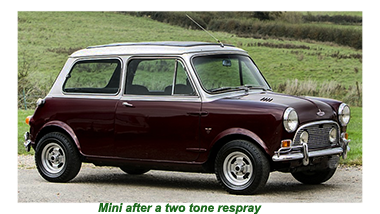 Lacquer was the first car paint and the sole option until the Eighties when developments in paint technology saw many rivals enter the market. Acrylic
Lacquer was the first car paint and the sole option until the Eighties when developments in paint technology saw many rivals enter the market. Acrylic
lacquers still command a fair share of the market as they are straightforward to apply and leave a vibrant gloss finish. The downside is that acrylic lacquer paints are liable to fade very quickly – especially under the sun's rays
Acrylic Urethane
Containing all the positive benefits of enamel and lacquer combined, with none of its downsides, Acrylic Urethane based paint is both easy to work with but will keep its finish for a very long time.
The only possible downside with Acrylic Urethane paint is that it will dry rapidly, meaning that it needs to be applied as soon as mixed.
Nitro-cellulose paint
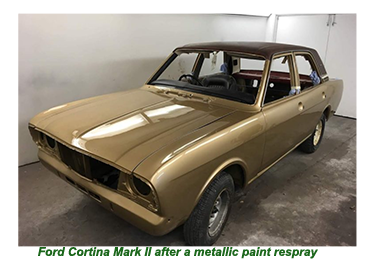 Most commonly used by paint shops that want to create a timeless classic car look, nitro-cellulose paint is user-friendly and hard-wearing.
Most commonly used by paint shops that want to create a timeless classic car look, nitro-cellulose paint is user-friendly and hard-wearing.
Nitro-cellulose needs to be applied with a certain amount of care as it is mildly toxic; it is a must wearing a basic breathing apparatus.
The actual spraying process will take very little time and required very basic equipment meaning that the job can be done in-house.
The downside with nitro-cellulose paint is that it will not produce a final finish independently, instead requiring considerable polishing till a high gloss shine can be achieved.
Water based paint
In recent years water-based paint has gained considerable popularity. Easy and safe to apply water-based paint needs to be backed up by at least one coat of lacquer. While this option may appeal to the amateur painter, it can prove more challenging because of the need to mix two paint types.
![]()
The type of paint used in a partial or full respray can only be genuinely settled when the colour options have been decided. There are a few options available, running as follows:
The first and far and away most popular is to spray the vehicle in a solid colour. Many restorers who have made an effort to maintain the vehicle's authenticity throughout the restoration process will go to considerable lengths to match paint colours to the original.
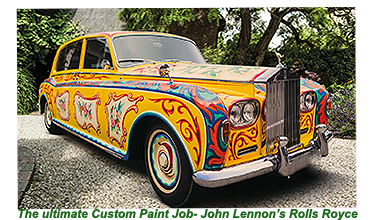 Finding an exact match for the existing paint will be a real challenge, as well as spraying the paint so accurately that it blends in accurately in the event of a partial respray.
Finding an exact match for the existing paint will be a real challenge, as well as spraying the paint so accurately that it blends in accurately in the event of a partial respray.
Taking on such a project requires skills that only an experienced painter will have at their disposal.
The same skills will need to be called on if the restorer decides to capture the Fifties' atmosphere by painting the vehicle in a two-tone finish.
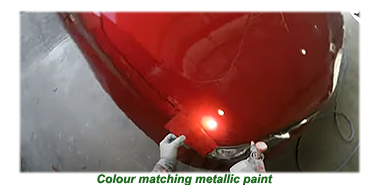 Painting in a solid colour is the most common and least expensive paint option when it comes down to it. Solid paint is always the least inexpensive, easy to apply and match, and any blemishes can be rapidly touched up.
Painting in a solid colour is the most common and least expensive paint option when it comes down to it. Solid paint is always the least inexpensive, easy to apply and match, and any blemishes can be rapidly touched up.
Another plus is that the restorer has access to an unlimited rainbow of colours, giving the vehicle a look that the manufacturers and designers could only dream about all these years ago.
 A relatively recent addition to the range of alternative finishes that was not around too much when most classic cars rolled off the production line is Metallic Paint
A relatively recent addition to the range of alternative finishes that was not around too much when most classic cars rolled off the production line is Metallic Paint
There are aluminium powder levels in metallic car paint which will provide any vehicle with a special glint.
 Metallic auto paint does have its downsides- first that it is more expensive than standard paint and limited in colour options.
Metallic auto paint does have its downsides- first that it is more expensive than standard paint and limited in colour options.
And as anyone who has ever owned a car with metallic paint will tell you, it can be very unforgiving with the slightest scrape or dent very difficult to match.
pw3

